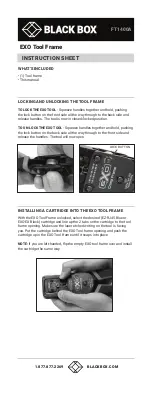
16
17
EN
ENGLISH
General Power Tool Safety Warnings
WARNING
Read all safety warnings, instructions, illustrations and
specifications provided with this power tool.
Failure to
follow all instructions listed below may result in electric shock,
fire and/or serious injury.
Save all warnings and instructions for future refe-
rence.
The term „power tool“ in the warnings refers to your mains-
operated (corded) power tool or battery-operated (cordless)
power tool.
1) Work area safety
a)
Keep work area clean and well lit.
Cluttered or dark
areas invite accidents.
b)
Do not operate power tools in explosive atmo-
spheres, such as in the presence of flammable
liquids, gases or dust.
Power tools create sparks which
may ignite the dust or fumes.
c)
Keep children and bystanders away while opera-
ting a power tool.
Distractions can cause you to lose
control.
2) Electrical safety
a)
Do not expose power tools to rain or wet condi-
tions.
Water entering a power tool will increase the risk
of electric shock.
Personal safety
a)
Stay alert, watch what you are doing and use
common sense when operating a power tool. Do
not use a power tool while you are tired or under
the influence of drugs, alcohol or medication.
A
moment of inattention while operating power tools may
result in serious personal injury.
b)
Use personal protective equipment. Always wear
eye protection.
Protective equipment such as dust
mask, non-skid safety shoes, hard hat, or hearing protec-
tion used for appropriate conditions will reduce personal
injuries.
c)
Prevent unintentional starting. Ensure the switch
is in the off-position before connecting to power
source and/or battery pack, picking up or carrying
the tool.
Carrying power tools with your finger on the
switch or energising power tools that have the switch on
invites accidents.
d)
Remove any adjusting key or wrench before
turning the power tool on.
A wrench or a key left
attached to a rotating part of the power tool may result
in personal injury.
e)
Do not overreach. Keep proper footing and balan-
ce at all times.
This enables better control of the power
tool in unexpected situations.
f)
Dress properly. Do not wear loose clothing or
jewellery. Keep your hair and clothing away from
moving parts.
Loose clothes, jewellery or long hair can
be caught in moving parts.
g)
If devices are provided for the connection of dust
extraction and collection facilities, ensure these
are connected and properly used.
Use of dust collec-
tion can reduce dust-related hazards.
3) Power tool use and care
a)
Do not force the power tool. Use the correct power
tool for your application.
The correct power tool will
do the job better and safer at the rate for which it was
designed.
b)
Do not use the power tool if the switch does not
turn it on and off.
Any power tool that cannot be
controlled with the switch is dangerous and must be
repaired.
c)
Disconnect the plug from the power source and/
or remove the battery pack, if detachable, from
the power tool before making any adjustments,
changing accessories, or storing power tools.
Such
preventive safety measures reduce the risk of starting
the power tool accidentally.
d)
Store idle power tools out of the reach of children
and do not allow persons unfamiliar with the
power tool or these instructions to operate the
power tool.
Power tools are dangerous in the hands
of untrained users.
e)
Maintain power tools and accessories. Check for
misalignment or binding of moving parts, breakage
of parts and any other condition that may affect the
power tool’s operation. If damaged, have the power
tool repaired before use.
Many accidents are caused by
poorly maintained power tools.
f)
Keep cutting tools sharp and clean.
Properly
maintained cutting tools with sharp cutting edges are
less likely to bind and are easier to control.
g)
Use power tools, insert tools, insert tools, etc.
according to these instructions. Take into account
the working conditions and the work to be carried
out.
Use of the power tool for operations different from
those intended could result in a hazardous situation.
h)
Keep handles and grasping surfaces dry, clean
and free from oil and grease.
Slippery handles and
grasping surfaces do not allow for safe handling and
control of the tool in unexpected situations.
4) Battery tool use and care
a)
Recharge only with the charger specified by the
manufacturer.
A charger that is suitable for one type
of battery pack may create a risk of fire when used with
another battery pack.
b)
Use power tools only with specifically designated
battery packs.
Use of any other battery packs may
create a risk of injury and fire.
c)
When battery pack is not in use, keep it away from
other metal objects, like paper clips, coins, keys,
nails, screws or other small metal objects, that can
make a connection from one terminal to another.
Shorting the battery terminals together may cause
burns or a fire.
d)
Under abusive conditions, liquid may be ejected
from the battery; avoid contact. If contact acci-
dentally occurs, flush with water. If liquid contacts
eyes, additionally seek medical help.
Liquid ejected
from the battery may cause irritation or burns.
Battery
a)
Do not use a battery pack or tool that is damaged
or modified.
Damaged or modified batteries may ex-
hibit unpredictable behaviour resulting in fire, explosion
or risk of injury.
EN
Содержание 58449
Страница 6: ...2 A B ...
Страница 7: ...3 1 1 2 2 CLICK 58555 58556 58557 18V 2 0 Ah 18V 3 0 Ah 18V 4 0 Ah ...
Страница 10: ...6 R R M I N 0 1800 min 1 220 Nm max 2100 min 1 250 Nm max M E D 2700 min 1 300 Nm max M A X ...
Страница 12: ...8 1 2 3 ...
Страница 73: ...69 ...
Страница 74: ...70 ...
Страница 75: ...71 ...
















































